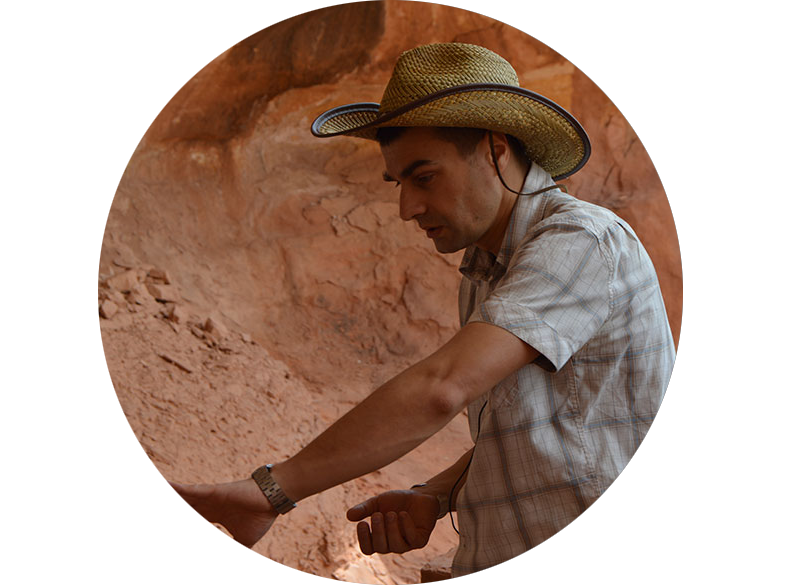
Radosław Palonka
Radosław Palonka, Ph.D., director of the project
Assistant professor at the Department of New World Archeology, Institute of Archaeology of the Jagiellonian University. He specializes in archaeology and anthropology of North America, focusing on the eastern and southwestern United States as well as the application of digital technologies in archaeological research. He has been a participant in many projects and archaeological studies in Poland, Europe, and the USA, for example at the Cahokia Mounds site, Illinois and at sites of Pueblo culture in Colorado. He received numerous and prestigious scholarships, including the Fulbright Commission grant (Arizona State University, Phoenix-Tempe, 2006-2007), Sasakawa Young Leaders Fellowship Fund/The Tokyo Foundation (University of Arizona, Tucson, 2008), or Kosciuszko Foundation grant (University of Arizona, Tucson, 2009). Since 2011 he leads the project: Sand Canyon-Castle Rock Community Archaeological Project focusing on socio-cultural changes in thirteenth century A.D. Pueblo culture in the Mesa Verde region, southwestern Colorado as well as documentation of rock art from the area. The research is conducted with financial support of the National Science Centre, Poland (grants Sonata and Sonata Bis), Jagiellonian University internal funds, as well as from American partners, mainly US Bureau of Land Management, Washington D.C. and Crow Canyon Archaeological Center, Colorado. He is also involved in popularizing archaeology and history of Native Americans in Poland and in Europe.
Ph.D.: Jagiellonian University, Faculty of History, 2009. Doctoral dissertation: “Defensive Architecture and the Depopulation of the Mesa Verde Region, Utah-Colorado, USA in the Thirteenth Century A.D.” (published in 2011 by Jagiellonian University Press)
Bolesław Zych
Jakub Śliwa
Jakub Śliwa, M.A. photographer, ethnologist, responsible for the photogrammetry and developed methods of digital photography of rock art and architecture as well as analysis of digital photography in the virtual environment, including DStretch, Photoshop and Adobe Lightroom enhancements and RTI (Reflectance Transformation Imaging) analysis; 3D visualisations of data and working on the developing methods of digital rock art documentation. Extensive experience in digital photography and conservation of rock art as well as medieval European sculptures and paintings, including main archaeological and historical sites in Poland (Royal Wawel Castle in Krakow, J. Slowacki Theater in Krakow; Basilica in Sandomierz), Egipt, India, and the USA. Knowledge of the HTML and WordPress and other web-design platforms and applications.
Robert Słaboński, M.A., photographer
Michał Znamirowski, M.A., archaeologist, photographer and graphic designer
Paweł Micyk, M.A., archaeologist, surveyor
Anna Wencel, MA, archaeologist, surveyor
Katarzyna Ciomek, MA (PhD student)
Anna Słupianek, MA (PhD student)
Magdalena Lewandowska, MA (PhD student)
Other main collaborators:
Kathleen O’Meara, PhD (architect, Maryland Institute College of Art., Baltimore): analysis of the architecture, landscape, and geography in Ancestral Pueblo communities in southwestern Colorado.
Barbara Błyskal, PhD (biologists, independent researcher): microbiological analysis of pottery and artifacts made from organic materials.
Paweł Dąbrowski, PhD (archaeologist, dendrochronologist, currently director of the Archaeological Museum in Biskupin, Poland): environmental and dendrochronological analysis.
Mark D. Varien, PhD (Vice-director of the Crow Canyon Research Institute/Crow Canyon Archaeological Center): consultations on the archaeology of the Mesa Verde region and tribal consultations (mainly with Pueblo groups).
Kristin A. Kuckelman, MA (Crow Canyon Archaeological Center): consultations on the archaeology of the Mesa Verde region and defensive architecture
Vince M. MacMillan, MA (chief archaeologist, Canyons of the Ancients National Monument): consultations on the archaeological research within the Canyons of the Ancients National Monument and general archaeology of the Mesa Verde region.
Thomas C. Windes, MA (archaeologist, dendrochronologist, University of New Mexico): cooperation in dendrochronological analyses of the sites in the Lower Sand Canyon area.
Gerard Huddlestone, surveyor, geodetic specialist, Cortez, Colorado.
Hopi tribal consultantsfrom the Hopi Cultural Preservation Office, Arizona (Leigh J. Kuwanwisiwma, Lee Wayne Lomayestewa, Ronald Wadsworth, Garry and Joel Nicholas, Delwyn Tawvaya, and Kevin James Crook): for the interpretation of function and meaning of the Ancestral Pueblo rock art, settlements, and landscape.
© Sand Canyon–Castle Rock Community Archaeological Project, 2021

